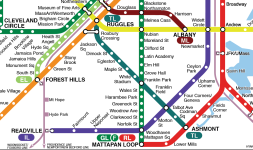Re Reading OLX: huh. I'm in the odd position of largely agreeing (I think) with
@TheRatmeister's ultimate conclusions, but disagreeing with the underlying methodology.
I'm assuming that, at the end of the day, fully grade separated RER through-running onto NSRL is an equivalent alternative to OL service.
Well, so, big disagree on this one. At the end of the day, a hypothetical version of the Orange Line could shovel 20 tph up to Reading (e.g. an entire tunnel's worth of trains); the only way NSRL gets to that level is if fully half of the trains in a 4-track tunnel run to Reading, and I'm deeply skeptical that Reading exceeds Waltham and Lynn in demand.
That being said, Reading getting a quarter of the NSRL's ~40 tph, yielding 6-minute headways, is somewhat more plausible (though unlikely). Which I think is your general point -- at this distance, the Orange Line probably doesn't need
full frequencies, so a "low rapid transit" frequency might overlap with a "high Regional Rail" frequency. And generally I think that's true in principle.
In practice, I think that RER would probably provide Reading with 15 or 20 minute frequencies, which is definitely not equivalent to the Orange Line. I'm not qualified to have a strong opinion on this, but it certainly seems to me that the more branches a system has, the lower effective capacity of the core section, given the greater complexity of scheduling interlining. Keeping Reading on the Regional Rail network makes everything more complicated for everyone, from Lynn to Brockton, Waltham to Providence. An OLX narrows the scope of the complexity.
So the options are:
- Start a long construction process, end up with an OL extension with amazing after 5-10 years.
- Electrify the line with overhead catenary now, end up with a line with great service much quicker, and then spend the next 5-10 years slowly eliminating grade crossings to elevate the service to amazing. Yes, this works out more expensive in the long run, but it yields much more immediate returns compared to the OL alternative. It's not letting "best" get in the way of "better." (And as a nice bonus the RER approach gets you express service along the current OL corridor without sacrificing service to Sullivan, Assembly, Rivers Edge, etc.)
Although I realize that potentially the biggest problem here is that there is a very significant temporal element not really present elsewhere that isn't really easy to convey with a static map.
This used to be my thinking as well, but I no longer think it's worth the trouble. From what I can tell, the current in situ conditions could probably yield 30 min headways wth diesel equipment. With some minor to moderate track adjustments south of Oak Grove, maybe that could even drop to 20 min.
In either option you describe, Melrose, Wakefield, and Reading will need to contend with 5-10 years of construction and disruption to service. (Are we really going to be able to do grade separations while thru-running trains?) So, those communities will have a choice: are 5-10 min frequencies really that much better than 20-30 min that it's worth a long term disruption?
If the answer is "yes", then just go ahead and build the Orange Line Extension. And if the answer is no, then continue on with the status quo, but without Indigo Line branding.
So I guess that's where I disagree a bit: I'm less enthusiastic about a Reading OLX, but I also don't particularly see good reason to try to turn the Reading Line into a northern Indigo Line.

